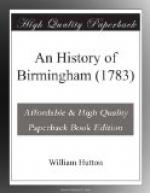Perhaps ostentation has brought forth more acts of beneficence than charity herself; but, like an unkind parent, she disowns her offspring, and charges them upon charity.
Ostentation is the root of charity; why else are we told, in capitals, by a large stone in the front of a building—“This hospital was erected by William Bilby, in the sixty-third year of his age, 1709.” Or, “That John Moore, yeoman, of Worley Wigorn, built this school, in 1730.”—Nay, pride even tempts us to strut in a second-hand robe of charity, left by another; or why do we read—“These alms-houses were erected by Lench’s trust, in 1764. W. WALSINGHAM, BAILIFF.”
Another utters the word charity, and we rejoice in the echo. If we miss the substance, we grasp at the shadow.
Sometimes we assign our property for religious uses, late in the evening of life, when enjoyment is over, and almost possession. Thus we bequeath to piety, what we can keep no longer. We convey our name to posterity at the expence of our successor, and scaffold our way towards heaven up the walls of a steeple.
Will charity chalk up one additional score in our favour, because we grant a small portion of our land to found a church, which enables us to augment the remainder treble its value, by granting building leases? a man seldom makes a bargain for heaven, and forgets himself. Charity and self-interest, like the apple and the rind, are closely connected, and, like them, we cannot separate one without trespassing on the other.
In contributions of the lesser kind, the giver examines the quantum given by those of his own station; pride will not suffer him to appear less than his neighbour.
Sometimes he surrenders merely through importunity, which indicates as much charity, as the garrison does merit, which surrenders when closely besieged. Neither do we fear our left hand knowing what our right hand doth, our only fear is, left the world should not know it.
This superb edifice was begun by act of Parliament, in 1711, under a commission consisting of twenty of the neighbouring gentry, appointed by the bishop of the diocese, under his episcopal seal. Their commission was to end twelve months after the erection of the church.
Though Birmingham ever was, and perhaps ever will be considered as one parish, yet a portion of land, about one hundred acres, nearly triangular, and about three fourths built up, was taken out of the centre of St. Martin’s, like a shred of cloth out of a great coat, to make a less, and constituted a separate parish, by the appellation of St Philip’s.
We shall describe this new boundary by an imaginary journey, for a real one perhaps was never taken since the land was first laid out, nor ever will to the end of time.




